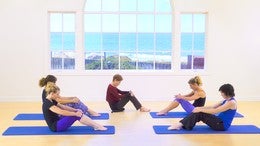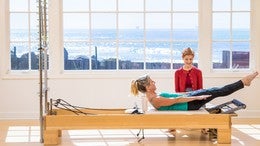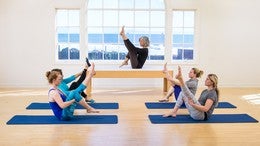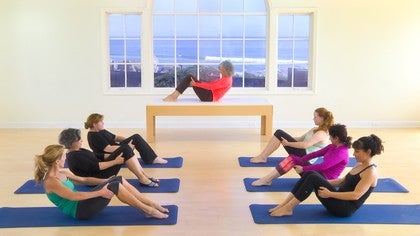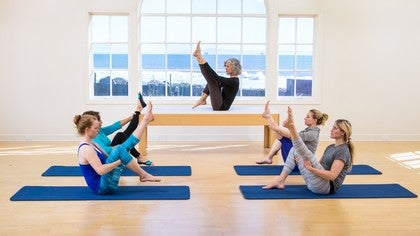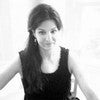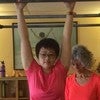Description
Just as the spiral motion of water is formed by the earth's movement, Wendy LeBlanc-Arbuckle invites you to play with the energetic natural movement of your Cobra Spine, as we explore a pre-test and post-test of Snake on the Mat, along with other potent movements. In this class, you will explore your spiraling spine through flexion, extension, and rotation movements that clarify its natural way of moving, while developing a new awareness that can be applied to any movement, and to your ability to be vital, strong, and self-healing.
This class starts with a detailed explanation of the spine and the waterfall concept. The movement in this class begins at 7:00 minutes.
About This Video
Transcript
Read Full Transcript
Hi and welcome back. So good to see you again. And I'm joined today by DJ and Hayley. Thank y'all so much for being here. We are going to explore together the Bio tensegrity of the Cobra spine and how that relates to our primary and secondary curves, which are not separate from one another because that is what creates spirals is the relatedness between the primary and secondary curves. So our little, our little flow skeleton here moves so beautifully and shows us how the spine moves freely and how rooted our arms and our legs are to our breathing spine. Let's um, let's take a look for a moment at two images.
Let's look at these beautiful 18th century anatomy images that I use in my teaching and they're down the backup the front. But let's first of all look at it down the back because in looking at that image, notice that I have three circles on the image that relate to lower core foot to pelvis, central core, pelvic floor to diaphragm, upper core diaphragm to Palette and cranial base and cranium. And notice how that relates to your entire spine. So, once again, there are not three cores in the body. Um, this is not a belief system. This is a way of wrapping our heads around the way our whole body relates to itself.
And how do we think from the lower body in the middle body and the upper body and how they all relate, right? But notice on there, we're calling the back image down the back and [inaudible] this image is note and notice that the muscles right alongside the spine, because I've only colored a few areas of each of the images just to have just enough to engage our minds around what are the gravity based muscles, what is the relationship to gravity, what's just enough to really get us in touch with our sense of gravity and lift, right? Which is what we're looking for. We're not looking for studying a million muscles. We really want to get in touch with and what helps us move more functionally and more freely, right? What's nourishing movement? So, and the image that uh, on the, on down the back on the yellow shoulder blade area is actually has a waterfall effect. And that's why the muscles right next to the spine, most multifidus muscles are blue because that is metaphorical for a waterfall, but the waterfall isn't just to your tail or to your sitting bones. Consider that the waterfall is actually a relationship into your feet to the earth. That's what's happening is that sense of exhale. When you exhale, they're just, you can just feel how your shoulder blades relax on your ribs and move toward your feet. They glide just a little bit. Well, that feeling of down down the back of the shoulder blades melting towards the sit bone, tailbone toward the tripod of the foot actually creates an internal spark up the front, and that is our suspension and reach our lift.
And that's why the other image up the front is demonstrating the lift that happens from the inner arch through the inner thigh, through the front of the pelvic floor along the front of the spine to the inner ear. And that creates a lift of our domes, the domes of uplift, the create suspension through our bodies. So that's the, once again, the arch of the feet is the first dome. The second dome as the pelvic floor, right? The third dome is the Dome of the diaphragm. The fourth dome is the Dome of the armpits. Place your fingers right here and just feel that you lift up and they'll let your shoulders drop and feel how your chest stays naturally lifted.
That relaxes your jaw and your tongue and your eyes and allows your head to release. See that that's a reset of your whole upper body that's supported by the pallet is another dome and the cranium is another down. So there is your lift from your grounding and that is what some what Judith Aston, who is one of my mentors, calls gravity, the grounding and ground reaction force lift. And I want to thank Judith for creating, helping to create this distinction for me many, many years ago, which has really deepened my own ability to bring forth my vision. And Judith is now teaching on polities anytime and don't miss what she has to teach, but also know that you don't want to glom onto only doing it one way.
You want to really take what she's saying and deepen your understanding of it. So that you're getting a sense of your body in motion. It's not about only doing something one way all the time. You want to mimic it first and then you want to feel what it feels like for you and really get it in your body. Okay, so the first thing that we're going to look at with our primary and secondary curves is what are they, what are the primary and secondary curves? So let's first of all, before I buy, I go into that. Let's do, we're doing a pretest and this'll be a movement that we're going to do before we do our exploration together.
And then we'll come back and do a post test of the same movement and we're going to do snake on the mat, which is a wonderfully fun flection extension rotation movement that we can examine how it feels when we first start. How do we feel? We come back to it afterwards cause that's what we want to feel. What's, what's changed, what feels new, what feels easier like that? So let's go ahead and show people how we're exploring that on the mat. And then we'll come back and look at specifically primary, secondary curves. Okay. So the first thing you want to feel for on your body, how do you set yourself up?
Each of us are different heights and we want to look at what feels good to us as we set ourselves up. So just like snake on the reformer, one hand is forward on the, on the head, on the shoulder rest, the other hand is on the carriage. So one hand is forward, the other hand is back. So whatever hand is forward, that foot is crossed over. So if right hand is forward, left hand back, you're gonna Cross your right foot over your left and then you'd notice where your hands want to be. That allows you to lift your hips up and dive your head and your hands down and your feet. And then as you look forward, you're coming through to look to the right and then you look down and you come back. And then let's do the other side left-hand forward, right hand back. So we're just feeling it, just feeling what it feels like.
So we're lifting up, releasing down through our hands and our feet and lifting our hips up. And then you go forward, you look to the left and then you release down to lift up and then we come back up. So that was the pretest, just to see what we noticed about that. So primary curves are those curves that are existent when we're a baby. So that is
And then
You lose the fact that that's supposed to be a secondary, um, curve. And it not only, not only that, but you actually in locking your knee, you lock your hip, you lock your back, you lock your abdominals, you lock your shoulders, your neck, your jaw. So no wonder there's so many things going on. If you haven't double checked with people, what are they doing that they don't need to be doing? So that's a main thing that we want to be aware of when we're teaching. And when you're doing your practice, what are you doing that's efficient for your body?
And that's just enough. So you're using yourself. Well, that's what we're studying. Okay, beautiful. So there's our primary and secondary curves and we're now we're going to look at that in relationship to movement, or what do we mean by that? So now let's get our chairs. Okay, so here we are.
First of all, place your hand at your chest and just notice as you sense the tension or the resiliency of your, of your skin. You know what? What tension do you feel as you look forward and just go to a pinpoint, go really, really fine like you're trying to see something like the head of a pin and keep looking, looking, looking really, really tiny, tiny, tiny. And notice that the skin under your hand begins to compress more and more and more. That is hard focus now soft focus and peripheral vision is now. Let yourself see the sides of the room.
And as you see the sides of the room, notice that your entire body expanded. So your eyes are direct relationship to your nervous system and your whole body just discovered it's three-dimensional relationship. Wasn't that fascinating? That's really amazing. So that is Cobra spine. The beginning of Cobra spine is peripheral vision. It's the image of the Cobra. The widening, the softening and widening of your eyes allows your jaw to be soft, allows your tongue to be soft, allows your chest to soften and widen.
So all of this gets to be open and wide and that allows your spine to be more flexible. And that begins to move your pelvis from a very different place. Cause usually we lock the sacrum and the pelvis together and move from the pelvis. So what we're going to do is we're, first of all, first of all going to do a distinction I called long sitting, which is a really valuable thing to do. Um, you know, the expression now is sitting is the new smoking. And that's true. If what you do is compress, compress, compress, all day long. But if you know how to reset your nervous system, then that doesn't happen and you actually free up your hips, free up your shoulders, free up your neck, free up your spine.
So it's how you set yourself up for movement. So long sitting, notice that we're on the, the sitting bones, right? You're on your sitting bones. Notice where your feet are. You want your feet to be directly under your knees and to feel comfortable, and then you're just going to come forward out of your hips. Pull your sit bones back. So you're on the front edge of your sitting bones. Notice that your your spine as he long gated and what's happening is your body thinks you're gonna stand up.
So it's created length. Now we're going to use that length to sit up. So feel how the weight of your body is in your feet, in the back of your leg and in the in the front of your pelvis. Press gently into your feet. Inhale and set up. Exhale and allow your shoulder blades to relax down and just feel how that feels more relaxed.
Notice that your back muscles probably feel softer. It's interesting because we are so used to doing this. We sit up from our back, usually feel the difference is as you sit up, push into your back a little bit and lift up and notice how that's engaging your back muscles and then come back. And now instead of doing that, just feel your sitting bones and feel your inner ear float up as your sitting bones release down. See how that relaxes your back. It lets it be softer. So now we'll do long sitting again from that distinction.
Come forward out of your hips, sense your sitting bones going back. You're on the front edge of your sitting bones. Press gently into your feet. Inhale to sit up. Exhale, waterfall down the back, internal, lift up the front. Feel that lift from the release. Can you move your head? How freaking your head be?
Can you move your arms? How free are your ribs as you move from the grounding of your lower body? Interesting, isn't it? Yeah. So that's long sitting. That's a distinction around sitting. And you just do that several times during the day. You do it in your car. I do it in the airplane when I'm flying. You know, I just do it all the time.
And what it does is it, it wakes up your parasympathetic relationship to your nervous system and, and eases and softens the sympathetic. So your body resets the nervous system and self calming. Now we're going to go to, um, a distinction of moving the Cobra spine inflection and extension or primary curves, secondary curve. And then we'll take that to rotation. And I'll talk more about that as you're moving.
We're not moving our pelvis yet. Okay. Your actually relaxing your pelvic bones and watch for just a second. As I look down my tail curls, as I look up my tail curls out, so your tail and your eyes, your head c curve to the front c curve to the back. Just a tiny. You see how you want to feel? What's tiny movement of your spine that allows you to feel the spinal movement as your tail moves towards your eyes and away from your eyes.
Yeah, it's very gentle movement. See that there's your Cobra. Now you're going to have your cobra spine. Move your pelvis, bring your hands back some on the outside, fingers inside. Feel that widening of your back and allow your eyes to look down as you feel the Cobra spine. Move your pelvis on your legs so you're rolling back slightly. Moving from the Cobra spine and then inner ear floats forward as you go onto the front of your sitting bones. Inhale and look up and keep the float as you rolled back and then look down.
So notice that you're moving in a gentle circle and in in her ear floats up and then you release over your sitting bones and release down. This Cobra spine is moving your pelvis, no muscular tension just rolling forward or your sitting bones for extension and secondary curve and rolling to the back of your sitting bones to feel the primary curve of your spine. This is how babies move. This is how children move. They just feel the movement, they feel it. They'll allow gravity to support them and it just feels so delicious and you're just allowing the movement to go bigger, but you're only going as far as it really feels good to your body.
What's just enough? How far do you go that has you not feel compressed. Your chest stays open, your hips stay open, you feel your feet, you feel your back widening, breathing. And then last one, as we go forward and come up, we'll come back to neutral and just sense how that felt, that nice primary and secondary. Now we're going to go into rotation and here we're, we're gonna.
We're gonna actually feel how the secondary and primary curves, how they support one another because just like flection extension, they're not separate from one another. They were, those are names we've put on them that all the body knows his movement, it just moves. And when it's ready to rotate it goes. It just goes into rotation because it's you say,
So we'll do that each side. Let's feel it right hand is gently moving. As your right hand
That's it. That's beautiful. Feel how you feel your feet, you feel your pelvis, you feel your spine and then from there you reach back to come up. Beautiful. Yeah, so now we're look at the primary and secondary curves,
There was a freedom in that. Interesting. That freeze up and then I reach out to come up. You may have even noticed that it affected your breathing because what happens is that it's very, very deep. It's a deep relationship that your body knows so well. When gravity supports you, you get free, right?
Right hand flows. What's just enough pressing? You're resting your leg against your arm. As you turn to the left and as you're looking to the left, it's your left shoulder to your right hip. That's, that's the secondary curve. That's an extension, and then your right shoulder to your left hip gets to release and allow your back to soften and open as you reach just up and notice how that frees up.
This back arm connects on a deeper level to your spine and then you can reach back to come up. Feel the reach to come up. Isn't that fascinating? Let's do one more. Each side reaching as you gently reach toward the floor on your left side, your right shoulder and left hip as an extension of spine on that side. And then your right now, your left shoulder and your right hip are neutralizing that extended side and then you reach back to come up. You see, you've pressed into your feet to feel the reach back so that you're getting more a spatial orientation. You see you're getting gravity and space to support you.
That's what children know that will take you into inversions. That'll be amazing. Yeah, just this feeling of, wow, my body is just so feeling. So free. One more time on this side. Right arm reaches. As you're looking left and as you reach, feel the spiral of your left shoulder to right hip. That's your secondary curve. And your primary is the right
That let that hip relax. Feel your foot. Feel how that frees up your mid back. How that frees up your left arm. And from there you reach back
So here we go. Sensing. First thing you want to do is make sure your feet are close enough to you cause you want to pull yourself into your feet, which is very different than throwing yourself into your feet. You say you want it to be close enough so it literally is a pouring into and left hand and feel your arms reach away from one another, feel your feet and then reach out to stand up, keep looking to the right, keep that spiral. And then from there you sit down. Having that sense of reaching back to sit down, it's not a different feeling. I know. Yeah. It's so fascinating to me as I began to explore it. You know, it's like, wow, this is amazing, this is important.
And then we reach, so our arms, here's the upper core reaching for gravity and space, right from the lower core grounding. And then you reach out to lift up, feel the waterfall down the back, feel your lift, natural lift, and then from there you keep that float, that lift as you sit down
What can you let go of that you don't need to be doing? What's just enough effort for the movement? What allows you to be in your feet and to feel your Cobra respond? You say you keep coming back to the context. You're coming back to what's just enough?
How can I let the waterfall, my arms connect to the down? How does that create lift naturally? One more time on this side. Right hand is reaching
Good. So here we are again. We're going back to our pretest, one of our pretests, which was the spiral, the standing spiral. So let's go. Haley, I want you to move forward just a little bit and turn this way. Look ahead and put your back here so we can look at the spirals, right? And, uh, and DJ, you can kind of be playing with the same thing too. So your right arm is reaching palm up, and as you turn to the right, as you turn feel, this is your extension side. So you're in the secondary curve from right shoulder to left hip.
And now the thing you want to check out, and this is what you want to check in your snake is can you allow that hip to relax? Can you feel the weight into that foot? So you can feel how your mid back softens up a little bit. Yes. And that allows the secondary and the primary curves to talk to one another and see how that gives you deeper rotation
Can you feel your foot? And you sense the support. See how that's just that tiny bit, how that just opens up a sense of support. That's it. Primary, secondary and then come back, right? Yeah. Good. Does that feel clear? Yeah. Whichever side is leading, that's your secondary curve. And the most important thing is to notice what's happening on the side that's neutralizing. Like as we now go into our snake on the mat.
So I'll be talking about that as we go from side to side. So now let's go back and do our post-test with snake on the map. So let's start with
The lift is tail lifted, butt shoulder blade to deep belly. He said, just relaxed my shoulder blades and my deep belly so I could really feel supported through my center. And then we look up and as you look up, you reach through. Now as you come through, the secondary curve is right shoulder to left hip. Can you relax your right hip into your foot? Relax that. Yeah. And see how that gives you more opening. That's it. You can look from side to side because you're in your deep support. See that and then look down to come up. Fascinating.
Huh? Amazing. Yeah. Let's go to the other side. Left-Hand forward, right-hand back. Notice for your body. What relationship, what do you need with your hands that allows you to lift your hips up? This is just like twist one. We want that feeling well. It's a similar setup to twist one so that a feeling of releasing down to create lift and then we look forward and as you look forward, syncing left shoulder to right hip as your secondary curve primary.
When can you reach that right hip back to allow
It's really about, it's really about having an understanding of what am I doing? What do I, am I doing what I think I'm doing? Because often we don't check in, right? You learn something and it may be a good idea, but you may have actually changed it yourself or it may not be working for you anymore. And how do you keep creating awareness around deepening your understanding so that your body's getting smarter and, and also you're getting more in touch with your body's wisdom teaching you. And that's what, that's what I've been studying for years, and that's what's growing me. And so many wonderful ways. I'm so grateful for. So fabulous to be with y'all. Thank you so much. Yeah. Yeah.
Wonderful. So thank you so much. See you soon.
Mindful Movement: The Brilliance of Your Biointelligent Body
Comments
How much of our lives do we reaaallly allow our peripheral vision to widen? I'll wager not even 10%. And primary and secondary curves!--in the span of 35 mins. those two concepts changed everything about how I habitually sense, move and react to the world.
For those wondering if and when to do this, I don't know if Wendy would agree, but I'd say this class is an exploration of micro movements with MACRO returns---if you fully embrace the ride. A sensing journey, if you will. Give yourself this gift when you are unhurried.
Ill be coming back again and again as a way to counter the effects of sitting in an office chair most of my life ... and as a way of neutralizing the effects of modern life, in general. Thank you, thank you!!
I wish you' d come to Spain someday.
You need to be a subscriber to post a comment.
Please Log In or Create an Account to start your free trial.
